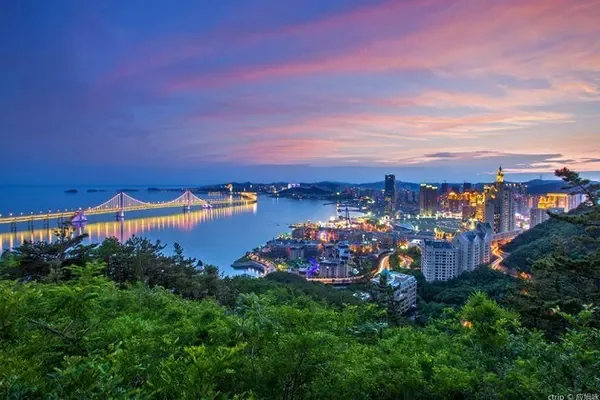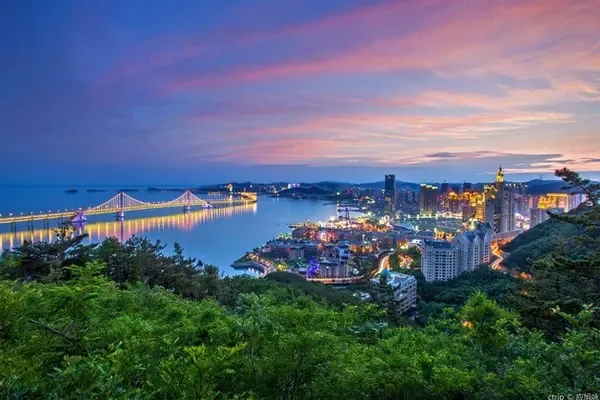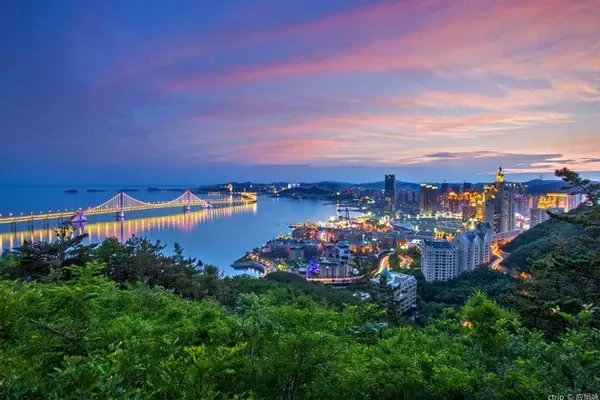Longxing Temple
Commonly known as the Great Buddha Temple, it is located in Dongmenli Street, Zhengding County. It was originally the Longteng Garden of Yan Murongxi during the Sixteen Kingdoms period of the Eastern Jin Dynasty. The dynasty was changed to Longxing Temple. In the fourth year of Kaibao in the Northern Song Dynasty (AD 971), according to Zhao Kuangyin's order, a copper Avalokitesvara with a thousand hands was built and built in the temple, and the Dabei Pavilion was built. layout and scale. In the Qing Dynasty, it was changed to Longxing Temple, and in the forty-ninth year of Kangxi (1710 A.D.), a plaque of "Edict to build Longxing Temple" was awarded. In 1961, it was listed as a national key cultural relics protection unit by the state.
Shuanglong glazed screen wall

According to legend, the Hutuo River in the south of Zhengding City is deep and fast, and two iron chains were cast and tied to the wooden piles on both sides of the river to facilitate pedestrians to ferry boats. Yuchi Jingde, who supervised the construction of the Great Buddha Temple, ordered the craftsmen to start building the screen wall in front of the Great Buddha Temple overnight, and embedded the two dragons in the middle, which not only suppressed the mosquito dragon, but also covered the defect that the Great Buddha Temple did not have a mountain gate.
Three-way single-hole stone bridge
Zhengding has
There is a saying "Three mountains are missing, and nine bridges are not flowing". It is said that Zhengding used to be called Hengshan, Changshan, and Zhongshan in ancient times. There is a three-way single-hole stone bridge in front of the halberd gate of the Confucian Temple. There is a pool under the bridge, and the water in the pool does not flow.

Palace of Heavenly Kings
"Mountain Gate" is the gate of Buddhist temples. Generally, there are three gates, namely "Empty Gate", "Wuxiang Gate" and "Wuzuo Gate", which symbolize the "Three Liberation Gates". It is often built into a hall style, and there are two statues of King Kong warriors in the hall. However, Longxing Temple did not build a "mountain gate", and visitors just checked in at the Hall of Heavenly Kings to enter. There is a legend in the local folk that "the temple is far away from the mountain gate, and the mountain gate is in Henan". In the early years of the Tang Dynasty, Yu Chigong supervised the construction of the Great Buddha Temple. Yu Chigong immediately rushed to the capital to rescue Qin Qiong. Because Yuchi Gong did not explain the construction plan of the mountain gate before his departure, the craftsmen dared not build it without authorization, and hurriedly chased Yuchi Gong to ask for instructions. Went to Henan to catch up with Yu Chigong and asked for instructions: "Where is the mountain gate of the Great Buddha Temple?" Yu Chigong pointed his horsewhip to the ground and said casually: "Let's build it here!" The craftsmen had no choice but to build the mountain gate locally. It is said that in Shanmen Township in Henan Province today, there is only Shanmen but no temples.

The Hall of Heavenly Kings was first built in the Northern Song Dynasty, and it is the earliest of the four existing Song Dynasty buildings in the temple. In the forty-fifth year of Qianlong reign of the Qing Dynasty (1780), major repairs were made, but the main beams remained in their original shape. The plaques of "Emperor Jianlongxing Temple" and "Tianwang Hall" were written by Emperor Kangxi.

The "Big Belly Maitreya Buddha" enshrined in the inner hall of the Tianwang Hall is a wood carving of the Jin Dynasty, which has a history of more than 800 years. This is a Maitreya Buddha that has been completely Sinicized. Its image originated from the Qiqi monk of the Yuelin Temple in Fenghua, Zhejiang Province in the Five Dynasties of my country. On both sides are the four heavenly kings who protect the world.

Mani Temple
Go through the Dajue Sixth Master Hall (base site) to the Mani Hall. Mani Hall is the "first and most" of Longxing Temple. The main body of the main hall is a square hall with a depth of seven rooms and a width of seven rooms. In the middle of the four sides of the hall, there is a mountain-shaped building with mountain flowers facing forward, forming a plane. cruciform. The bucket arches under the eaves are large and sparsely distributed; the pillars are made of thick materials, with obvious rolling brakes, side angles and rises, which are similar to the "Zao Fa Shi" of the Song Dynasty. Emperor Kangxi praised it as "magnificent, like a big roc spreading its wings"; Mr. Liang Sicheng said that this layout was only seen in Song paintings except for the turrets of the Forbidden City in Beijing's Forbidden City.




On the Buddhist altar in the Mani Hall, there are five clay sculptures and golden Buddha statues. In the center is the Buddha Sakyamuni. On the left and right sides are Kasyapa and Ananda. These five statues are all original sculptures of the Song Dynasty, and Manjusri and Puxian were repaired in the Ming Dynasty. The walls in the hall are murals with Buddhist stories as the theme. On the north wall of the trough in the hall is a clay sculpture colorful hanging mountain, among which "Inverted Avalokitesvara" is the second most in Longxing Temple. The Guanyin statue was originally made in the Northern Song Dynasty, and it was repaired in the 42nd year of Jiajing in the Ming Dynasty (1563). Mr. Lu Xun praised her as "personifying God".

altar

According to legend, at the end of the Western Han Dynasty, a rich lady in Zhengding City flirted with a young long-term worker in her family, but the lady's parents firmly opposed them. Willing to be Lian Lizhi on the ground. After finishing speaking, it immediately turned into two locust trees here. Liu Xiu, Emperor Guangwu of the Han Dynasty, was deeply moved when he saw this tree, and named it Longfenghuai. Later generations also called it the husband and wife tree and the marriage tree.

Jietan is a pavilion-style building with a square plane, five rooms wide and five rooms deep. The existing wooden structure was rebuilt in the Qing Dynasty.

There are sharp roofs at the four corners, three-story eaves on all sides, and the corridors of the surrounding steps cover the platform foundation. The plaque of "Jinshengjue Road" comes from Li Bai's "Returning to the Mountain in Spring to Send Meng Haoran" "Golden Rope Opens the Jue Road, and the Raft Travels the Misty River." The altar has three floors and four sides. On the top is a bucket arch structure, supporting the large eaves of the entire precept altar. The roof of the precept altar is a pointed roof with four ridges, and there are six mythical beasts on each ridge. Inside the altar is a copper-cast double-faced Buddha statue of the Ming Dynasty.

Zhuanlun Tibetan Pavilion
Zhuanlunzang Pavilion is a two-story pavilion in the Northern Song Dynasty. There have been different degrees of repairs in the past dynasties. In 1956, the State Council allocated funds for the reconstruction. The eaves added during the reconstruction in the Ming Dynasty were removed, and the original appearance of the building in the Northern Song Dynasty was restored. The beam frame structure of Zhuanlunzang Pavilion adopts the method of large curved beams and inserted columns. The lower floor of the pavilion adopts the method of moving columns due to the placement of Zhuanlunzang, while the eaves columns adopt the method of inserting columns. Outstanding features of the Song Dynasty.

The Zhuanlun Tibetan Pavilion in the Northern Song Dynasty is the third largest in Longxing Temple. It is the oldest and largest wooden structure cabinet in my country. It is made of octagonal wood with a diameter of 7 meters. There are three parts, the Tibetan top, and a 10.8-meter wooden shaft is set up in the middle to run through it up and down, and the weight is borne by the bottom Tibetan needle. The upper eaves are round and the eaves are flying, which is a typical method of "Zao Fa Shi" in Song Dynasty. The double eaves, the lower eaves are octagonal, and the bucket arch style is made of Bapu, which is an example of the most jumping bucket arches in early my country.


Cishi Court
Cishi Pavilion is a hall dedicated to Maitreya, with a width of three rooms and a depth of three rooms. It is a two-story pavilion-style building in the Northern Song Dynasty. In Yuan, Ming and Qing Dynasties, it was rebuilt to varying degrees. The beam frame structure is made of reduced columns and Yongding columns, which are known as the "Nine Wonders of the Great Buddha Temple". The method of reducing the pillars is concise and clear, which is convenient for tourists to watch and pay homage to the Buddha. The Yongding column construction method adopted by the eaves column is an isolated example of the existing Song Dynasty architecture in my country. The Maitreya Bodhisattva with a height of 7.4 meters is enshrined in the pavilion. It was carved from a single log in the Northern Song Dynasty, and its shape is the orthodox Maitreya statue in Buddhism.

Monument of Longzang Temple
The stele of Longzang Temple is the fourth largest in Longxing Temple. This stele was erected in the sixth year of Emperor Kaihuang (586). The situation of common people building Longzang Temple together is an important relic for studying the history of Longxing Temple. The head of the stele is 82 centimeters high, inscribed in regular script "Hengzhou Governor E Guogong persuaded the country to build the Longzang Temple Stele". The stele is 164 centimeters high and 90.5 centimeters wide, with 30 lines of regular script inscribed on the front, 50 characters in each line, totaling 1,447 characters. The inscriptions on the inscriptions are well-organized in calligraphy, rigorous in structure, simple but elegant, solemn but not inflexible, and slightly reveal the legacy of Wei Li. It is an important stele for studying the art of calligraphy in the transition period from Wei Li to regular script, and is one of the famous steles in China. Ouyang Xiu recorded this stele for the first time in "Ji Gu Lu", and Kang Youwei in modern times called it "the first stele of the Sui Dynasty", and later generations called it the first stele of regular script.

Dabei Pavilion
Dabei Pavilion is the main building of Longxing Temple, with five eaves and three floors, 33 meters high. It was built in the Kaibao period of the Northern Song Dynasty. The supporting halls on both sides are Yushulou and Jiqing Pavilion. The three halls were all built in the Northern Song Dynasty, and the existing buildings were rebuilt in 1999.

Inside the pavilion is the highest-preserved bronze statue of Guanyin Bodhisattva in China, which was cast by the order of Taizu Zhao Kuangyin in the fourth year of Kaibao in the Northern Song Dynasty (971). The statue is 21.3 meters high and has a total of 42 arms. The body part of the existing Avalokitesvara statue and the two arms that fold into the chest are made of bronze in the Song Dynasty. It is said that when this Guanyin statue was cast 1,000 years ago, it was cast in seven segments by using the method of digging soil. It is because of its existence that people naturally call Longxing Temple "Great Buddha Temple". This is the fifth largest in Xinglong Temple. The upper square of Xumizuo in Dabei Pavilion and the inside of the pot door are engraved with decorative patterns, Jiyue, Feitian, Panlong and other exquisite Song Dynasty carvings.






Pilu Hall

Longteng Court

Longquan Well Pavilion is a Ming Dynasty building with double eaves and roof. There is an ancient octagonal glazed well in the pavilion. According to the "Longxing Temple Records", Longquan Well is the place where "water floats wood and earth springs copper" in the Song Dynasty, and "dragon dives in it, and it responds to rain", so the octagonal well is also called "Longquan Well". "Lingquan Well".



